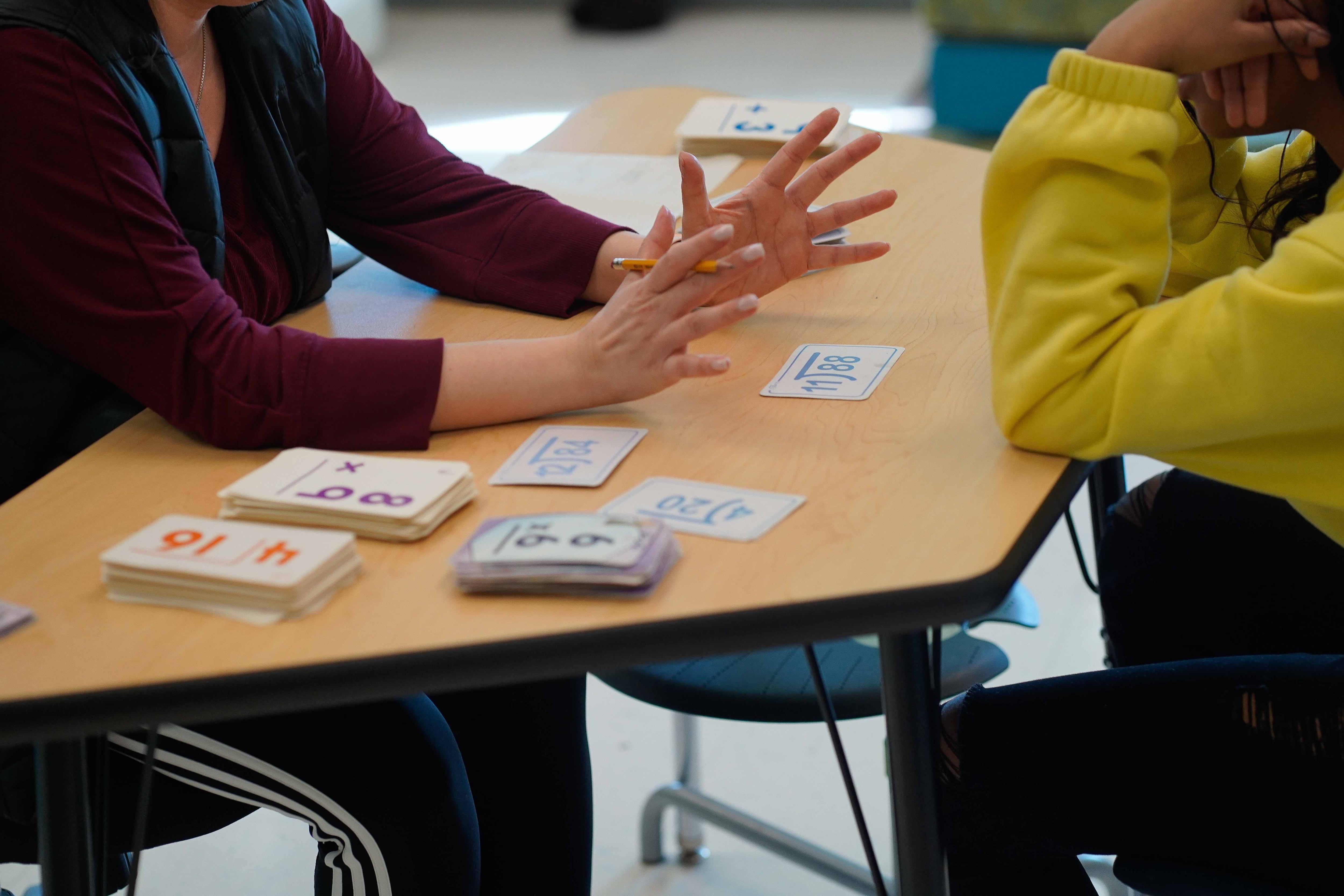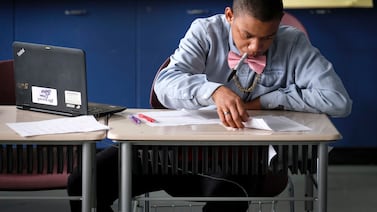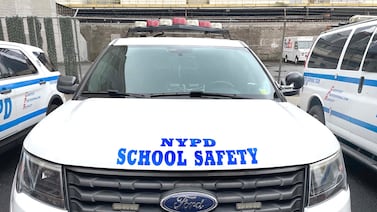Sign up for Chalkbeat Chicago’s free daily newsletter to keep up with the latest education news.
Chicago Public Schools students’ reading scores are recovering faster since the pandemic than most school districts across the country, according to a new national report.
The district’s surprising rebound, documented by researchers at Center for Education Policy Research at Harvard University and The Educational Opportunity Project at Stanford University, also found the state of Illinois led the nation in reading growth between 2022 and 2023 and is one of just four states to return to pre-pandemic achievement levels.
However, the bounce back has not been as strong in math. Both Illinois and Chicago were in the middle of the pack for math score recovery compared to other states and districts.
Chicago Chief Education Officer Bogdana Chkoumbova attributed the growth to how the district spent its federal COVID money.
“The federal pandemic aid actually has allowed us to invest fully in the day-to-day what I call the bread and butter of education,” Chkoumbova said.
Chicago spent a large portion of its $2.8 billion allocation on existing staff. Documents obtained by Chalkbeat in 2021 showed the district planned to use the money to cover salaries and benefits for roughly 30% of its workforce. Expenditure data obtained by Chalkbeat late last year indicates $1.4 billion of the $2.4 billion spent so far went to staff salaries and benefits.
CPS employed just over 38,000 people on the eve of the pandemic, and staffing records show that number has grown to more than 43,500 as of Dec. 31, 2023. The district’s overall budget grew from $7.7 billion the year the pandemic hit to $9.4 billion this school year.
A lot of the district’s increased staff costs were tethered to specific initiatives aimed at helping students recover from two years of disrupted learning:
- The district tapped hundreds of mostly existing staff within schools to become academic interventionists, who worked one-on-one or in small group settings with struggling students.
- CPS also hired hundreds of tutors across the school system and worked with an outside company to do high-dosage tutoring. According to a district spokesperson, 600 tutors in 230 schools provide tutoring in reading and math during the school day.
- Summer school and after-school programs expanded significantly over the past few summers — spending between $20 million and $40 million each summer. However, tracking student participation has proved difficult.
- Chkoumbova said the district has also hired more than 180 “instructional coaches” dedicated to supporting teachers and school staff in schools with the highest needs.
The growth in CPS between the 2021-22 and 2022-23 school year documented by researchers at Harvard and Stanford on their Education Recovery Scorecard bucks a broader trend of widening inequity between high-poverty and wealthier districts.
According to the data, Black student scores in CPS grew even more than the district average in reading. District officials said their improvement meant they “emerged from the pandemic two-thirds of a year ahead of where they were in reading than before the pandemic.”
“Our teachers, our staff, our principals, assistant principals, they also have experienced the effects of the pandemic, but they really stepped in a big way and I think it has to be celebrated,” Chkoumbova said.
State test score data released last fall showed more Chicago students were catching up, but still remained below pre-pandemic achievement levels. Gaps between Black and Latino students and their white and Asian counterparts remain and there’s more work to be done to help students with disabilities and immigrant students, Chkoumbova said.
With federal COVID money running out later this year, Chicago Public Schools is projecting a $391 million dollar shortfall. Officials have been urging the state to increase funding.
“We have a good plane that we can fly. We just need a lot more fuel to sustain the speed with which our students are recovering and also to gain some altitude,” Chkoumbova said.
Governor J.B. Pritzker is set to release his budget proposal next week and state education officials have proposed increasing overall education funding by more than $650 million next year, which includes increases for both K-12 and early childhood education. Lawmakers will have the final say over how much is ultimately allocated.
Pre-pandemic progress may have helped rebound
This is not the first time Stanford researchers have found promising academic growth in Chicago Public Schools.
A report released in 2017 that looked at test scores between 2009 and 2014 found Chicago students saw six years of growth in five and were improving faster than 100 of the nation’s largest school districts.
Paul Zavitkovsky, an assessment specialist at the Center for Urban Education Leadership at the University of Illinois Chicago, did a similar study that same year looking at 15 years of data and found the often negative perception of Chicago Public Schools did not match reality. In his study at the time, CPS students in every demographic group were outscoring their counterparts in the rest of the state.
He said that the latest pandemic recovery identified by national researchers could be due to the “carry-over impact” of high reading achievement levels of students in second, third, and fourth grades at the end of 2019. These students, Zavitkovsky said, “entered the pandemic better prepared than any comparable cohort in CPS history.” He likened their academic bounce back to a sponge.
“If you have a sponge, and it hasn’t had water for a long time, it tends to shrivel up a little bit,” he said. “When you pour water on it, it immediately soaks up that water because it’s got all this sort of latent capacity to absorb it.”
He cautioned that the promising growth may not last forever and raised concerns about students who may have missed key early literacy instruction.
Chkoumbova, who also worked as a teacher and principal in CPS, said the district has been focused on early literacy for decades. On the eve of the pandemic, the district released a new literacy framework and when schools returned in-person, she said they emphasized the importance of strong foundational reading skills in kindergarten through fifth grade.
“We have been getting a little bit more specific about the need for this explicit teaching of foundational skills, phonics, phonemic awareness,” she said. “Our schools are really embracing this effort.”
She added that many schools have been using early literacy curriculum that is part of the district’s universal curriculum bank Skyline, which launched during the pandemic, or a curriculum from Wilson Reading. A district spokesperson said Skyline has been adopted on a voluntary basis by nearly half of CPS schools.
Cautious optimism as other indicators lag
Elaine Allensworth, Lewis-Sebring Director of the UChicago Consortium, said the findings were “exciting and surprising,” but also a little puzzling because attendance is still low and absenteeism is still high.
“Maybe there’s just a lot of focus on math and English language arts instruction right now because people are so worried about pandemic learning loss,” Allensworth said. “I know a lot of teachers feel under pressure to increase students’ test scores… which makes me nervous, honestly, because then I start to wonder, ‘Well, what are they not doing?’”
Chkoumbova said for the past two years, her message from the top has been to keep challenging students with grade-level work and “resist that urge” to do too much remediation on basic skills.
“If it is kill and drill and remediation, kids will not love coming to school,” Chkoumbova said.
She said she is “paying very close attention” to rates of chronic absenteeism. In Illinois, a student is considered chronically absent if they miss 10 percent – or roughly 18 days — in a school year, regardless of whether the absence was excused or not.
The percentage of chronically absent students in Illinois shot up in the 2020-21 school year and got even worse in 2021-22. In CPS, 39.8% of students were chronically absent during the 2022-23 school year, down from 44.6% the previous year.
But Allensworth said Chicago schools use data and research more and collaborate more frequently across teacher teams and networks – both of which are associated with school improvement.
“I think there’s just a lot of different things that are going on in Chicago that are different than other places,” Allensworth said. “It’s not glamorous or scandalous or whatever. And so locally people don’t know but people outside of Chicago look at Chicago as a place that’s kind of an exemplar in a lot of ways.”
Becky Vevea is the bureau chief for Chalkbeat Chicago. Contact Becky at bvevea@chalkbeat.org.





